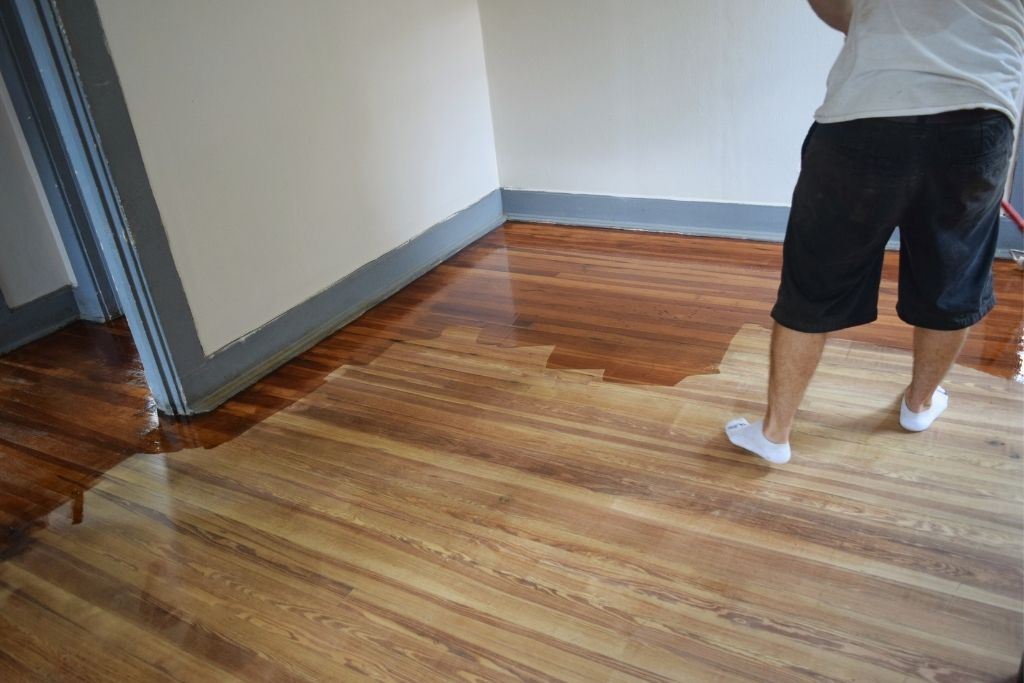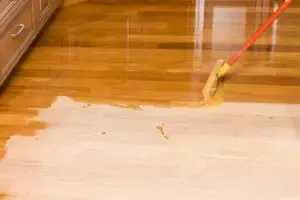
What is the correct number coats of polyurethane to apply to different wooden surfaces?
This is a question that many people want the answer to, but it can be difficult to determine exactly how many coats of polyurethane you need to add.
Since polyurethane can be a bit tricky to apply correctly. It’s important to understand the basics before getting started.
In this article, we’ll cover everything you need to know about applying polyurethane and give offer recommendations for the ideal number of coats to achieve optimal results.
Keep reading to learn more!
Table of Contents
- What Is A Polyurethane Coating?
- What Are The Benefits Of Polyurethane?
- How Many Coats Of Oil Based Polyurethane?
- How Many Coats Of Water Based Polyurethane?
- Is One Coat Of Polyurethane Enough?
- Tips For Apply Polyurethane
- Frequently Asked Questions
- Is Polyurethane The Same As Polycrylic?
- How Many Coats Of Polyurethane On Table?
- How Many Coats Of Wipe On Poly?
- Is 2 Coats Of Polyurethane Enough?
- How Many Coats Of Polyurethane On Wood Countertops?
- How Many Coats Of Polyurethane On Cabinet?
- How Many Coats Of Polyurethane On Furniture?
- Can You Put Too Many Coats Of Polyurethane?
- How Many Coats Of Water-Based Polyurethane On Hardwood Floors?
- How Many Coats Of Polyurethane On Stairs?
- What Is The Best Way to apply polyurethane?
- Can I Apply Polyurethane Over Varnish?
- What Is The Dry Time For Polyurethane?
- Can I Use Water Based Polyurethane On Kitchen Cabinets?
- Can I Use A Roller For Polyurethane?
- What Grit Sandpaper Should I Use For Sanding Between Coats Of Polyurethane?
- Can I Use Polyurethane Over Paint?
- Should I Sand After Every Coat Of Polyurethane?
What Is A Polyurethane Coating?
A polyurethane coating is a synthetic resin that is applied to wood in order to protect it from the elements and to give it a glossy finish.
Polyurethane coatings come in both oil-based and water-based formulas, and they can be either clear or pigmented.
Oil-based polyurethanes are more durable than water-based polyurethanes, but they are also more toxic and harder to apply.
Water-based polyurethanes are less toxic and easier to apply, but they don’t last as long.
Both types of polyurethane can be used for indoor and outdoor projects. But oil-based polyurethanes are better suited for outdoor projects because they are more resistant to UV damage and against color loss.
What Are The Benefits Of Polyurethane?

Polyurethane coatings offer several benefits, including:
- Protection against moisture and water damage
- Protection against UV damage
- Resistance to staining and fading
- A glossy finish that enhances the appearance of wood surfaces
- Protection against scratches and other physical damage
- Polyurethane can be used on any wooden surface, including floors, cabinets, furniture, and decks.
- It is especially important to use polyurethane on exterior wood surfaces to protect them from the elements.
How Many Coats Of Oil Based Polyurethane?
Most experts agree that 2 – 3 coats of oil-based polyurethane is the ideal number for most projects.
However, you may need more or less depending on the type of wood you are using and the level of protection you need or high gloss finish.
If you are using an oil-based polyurethane for an outdoor project, it is a good idea to apply four or five coats.
How Many Coats Of Water Based Polyurethane?
Your finish will be optimum with 5 or 6 coats of water-based polyurethane. For a less durable surface, three-layer can create an adequate look but sacrifice smoothness and clarity in the finish.
Is One Coat Of Polyurethane Enough?
One coat of polyurethane will not be enough to protect your wood from the elements or from physical damage. Also, it will not give a glossy finish as if you applied two or three coats
Most people apply between two and four layers of polyurethane, but this number can vary depending on the type of wood you are using and the level of protection you need.
Tips For Apply Polyurethane
Applying polyurethane can be a bit tricky, so it’s important to understand the proper application techniques before getting started.

Here’s some tips for applying polyurethane:
- Always test your polyurethane coating on a small, inconspicuous area of your wood project to make sure it is compatible and that you are happy with the results.
- Be sure to stir the polyurethane coating well before using it.
- Do not apply polyurethane in direct sunlight or in high humidity conditions.
- Do not apply polyurethane over paint that is still wet.
- The first polyurethane layer should be slightly thicker, as it needs to stick well and create an even surface.
- Make sure your wood is clean and free of dust, dirt, and other debris before applying the polyurethane coating.
- Apply the polyurethane in thin coats, using a brush or a roller. Do not apply too much at once, or it will be difficult to smooth out.
- Make sure to sand between polyurethane coats using fine-grit paper. This way, you won’t have any awkward streaks or scratches under the final layer of paint.
- Allow each coat of polyurethane to dry completely before applying the next one. This can take anywhere from several hours to a few days, depending on the weather and the type of polyurethane you are using.
- If you are using an oil-based polyurethane, be sure to use a respirator and safety goggles to protect yourself from the fumes.
- Be careful not to get the product on your skin or in your eyes. If this happens, rinse with plenty of water and seek medical attention if necessary.
Frequently Asked Questions

Is Polyurethane The Same As Polycrylic?
Polyurethane and polycrylic are both types of finishes, but they have different properties.
Polyurethane is a thicker, more durable finish, while polycrylic is a thinner, less durable finish. Polycrylic can also be used on top of polyurethane to create a glossy finish.
How Many Coats Of Polyurethane On Table?
To get the best results, apply at least three coats of polyurethane to your table. You can add more if you want it sleek and glossy.
How Many Coats Of Wipe On Poly?
The number of coats you’ll need for a particular application will vary depending on how much glossier your final coat is and if it scuffs easily. 3-5 good even applications with wipe-on poly should be enough to do the job right, though.
Is 2 Coats Of Polyurethane Enough?
It’s good enough to protect your wood from both moisture and contaminants. However, if you want maximum protection against water damage then three or four coats will be necessary.
How Many Coats Of Polyurethane On Wood Countertops?
In order to protect your investment in wood countertops, you should apply at least two coats of polyurethane.
If this surface will heavily use or if it is water-based and raises the grain when applied too thickly then consider applying 4 -5 coats for protection against scratches.
How Many Coats Of Polyurethane On Cabinet?
To give your cabinets that professional look, you should apply at least three to four coats of polyurethane.
If the stain is deep and there was water-based paint involved in its application then only two total layers.
However, if it’s oil-based paints were used for finish coverage than an extra coat or two might helpful so it covers better against wear over time.
How Many Coats Of Polyurethane On Furniture?
The answer depends on the type and condition, but generally speaking 2-3 will do for refinishing old woods. Otherwise, it can up to 5+ coats could be required if you want an authentic look with grain or color contrast restored instead
Can You Put Too Many Coats Of Polyurethane?
If a coat of polyurethane is enough to cover the surface, adding more coats will not improve protection or shine. The more coats you add, the longer it may take to dry.
Four or even six can cause peeling in some cases – especially if they’re too thick.
Three good quality polyurethane layers should do just fine though. Three coats are usually enough when applied properly by an expert handyman.
How Many Coats Of Water-Based Polyurethane On Hardwood Floors?
Hardwood floors are often recommended to be sealed with three or four coats of water-based polyurethane, depending on the type. But if you don’t get a smooth finish by the fourth time then sand it and do another coat.
How Many Coats Of Polyurethane On Stairs?
You will need at least three coats of polyurethane on stairs for maximum protection.
What Is The Best Way to apply polyurethane?
The best way to apply polyurethane is with a brush. This will help ensure that the polyurethane coats the surface evenly. You can also use a foam roller for larger surfaces.
Can I Apply Polyurethane Over Varnish?
You can apply polyurethane over most types of varnish, but it is important to make sure the varnish is fully cured first. Also, you should test the compatibility of the two products in a small area first.
What Is The Dry Time For Polyurethane?
It will vary depending on the type of polyurethane, the weather, and the surface being coated. Generally, allow at least four hours between coats and 24 – 48 hours before using the surface being coated.
Can I Use Water Based Polyurethane On Kitchen Cabinets?
Yes, but you will need to apply at least four coats in order to achieve the desired level of protection.
Water-based polyurethanes are also less likely to raise the grain of your wood, so they may be a better choice if your cabinets are already finished.
Can I Use A Roller For Polyurethane?
You can use a roller for polyurethane, but it is not recommended. A brush will allow you to apply the polyurethane more evenly and will help prevent streaks.
What Grit Sandpaper Should I Use For Sanding Between Coats Of Polyurethane?
For best results, use fine-grit sandpaper (between 150 and 220 grit) when sanding between coats of polyurethane. This will help ensure that the surface is smooth and that the next coat of polyurethane will adhere properly.
Can I Use Polyurethane Over Paint?
Yes, you can use polyurethane over most types of paint. However, it is important to make sure the paint is fully cured before applying the polyurethane. Otherwise, the polyurethane will not adhere properly and will peel off.
Should I Sand After Every Coat Of Polyurethane?
No, you should only sand between coats if there are any noticeable streaks or scratches. Be sure to use fine-grit sandpaper for the best results.






